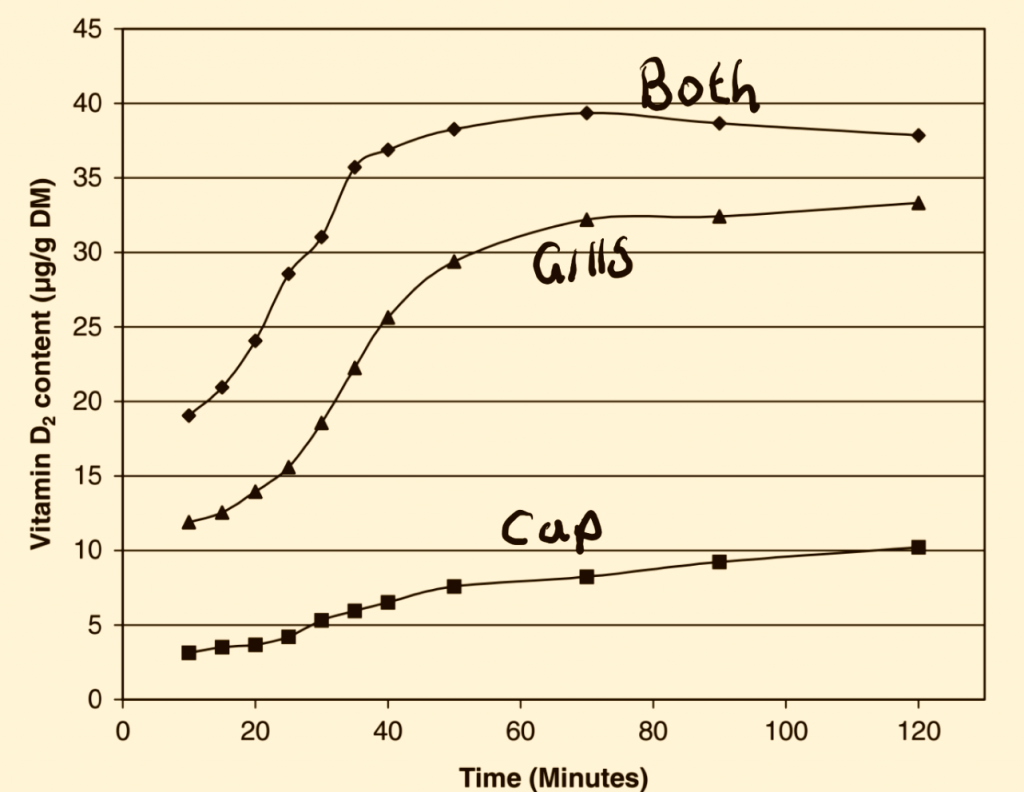 Mushrooms are a good source of vitamin D, but the vitamin D content of mushrooms varies depending on the growing conditions. In particular, the amount of ultraviolet light that the mushrooms are exposed to has a significant effect on the vitamin D content of the mushrooms. For example, in one study researchers exposed Fresh shiitake mushrooms (Lentinula edodes), oyster mushrooms (Pleurotus ostreatus), button mushrooms (Agaricus bisporus) and abalone mushrooms (Pleurotus cystidus) with ultraviolet A (wavelength 315 to 400 nm), ultraviolet B, (wavelength 290 to 315 nm), and ultraviolet C (wavelength 190 to 290 nm) on each side. The results of the study showed that one hour of irradiation was the optimal time period to generate the maximum amount of vitamin D. Therefore exposing mushrooms of various types to ultraviolet light might be an effective way to increase the vitamin D content of the mushrooms, and therefore to subsequently increase the vitamin D content of the diet.
Mushrooms are a good source of vitamin D, but the vitamin D content of mushrooms varies depending on the growing conditions. In particular, the amount of ultraviolet light that the mushrooms are exposed to has a significant effect on the vitamin D content of the mushrooms. For example, in one study researchers exposed Fresh shiitake mushrooms (Lentinula edodes), oyster mushrooms (Pleurotus ostreatus), button mushrooms (Agaricus bisporus) and abalone mushrooms (Pleurotus cystidus) with ultraviolet A (wavelength 315 to 400 nm), ultraviolet B, (wavelength 290 to 315 nm), and ultraviolet C (wavelength 190 to 290 nm) on each side. The results of the study showed that one hour of irradiation was the optimal time period to generate the maximum amount of vitamin D. Therefore exposing mushrooms of various types to ultraviolet light might be an effective way to increase the vitamin D content of the mushrooms, and therefore to subsequently increase the vitamin D content of the diet.

Exposing mushrooms to ultraviolet light can significantly increase the vitamin D content of the mushrooms. In shiitake mushrooms, ultraviolet A light significantly increases vitamin D production, and this production is greatest when the gills (the lower covered slit-like surface) are exposed, compared to when the cap (top rounded part) is exposed. Turning the mushrooms so that both the cap and the gills are irradiated generates a significantly larger amount of vitamin D compared to exposing one surface or the other. As the ultraviolet light content of the sun is mainly (95 %) ultraviolet A, turning the mushrooms in the sun for about 1 hour likely significantly increases the vitamin D2 content of the mushrooms. Both = cap and gill exposed, cap = cap exposed, gills = gills exposed.
Vitamin D2, ergocalciferol is synthesised from ergosterol in mushrooms, and this process is catalysed by ultraviolet light. This reaction is very similar to the conversion of cholesterol to vitamin D3 (cholecalciferol) in humans. In the same study, there was also a significant difference in the amount of vitamin D2 generated based on the type of ultraviolet light used. Ultraviolet B light consistently produced a greater amount of vitamin D2 in all types of mushrooms, while ultraviolet A light consistently produced the least amount of vitamin D2, although the difference was small. There was also a large difference in the response of the different mushrooms. For example, oyster mushrooms responded very well to ultraviolet B light at 35 °C and 80 % moisture with a vitamin D concentration of 184 μg/g dry mass, whereas button mushrooms generated a vitamin D2 concentration of only 58.5 μg/g dry mass in similar conditions. Sunlight contains around 95 % ultraviolet A light with the rest mainly ultraviolet B light.
Eat Well Stay Healthy, Protect Yourself
RdB
